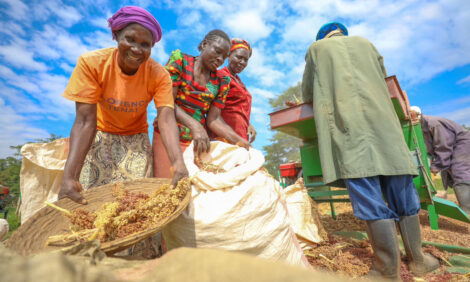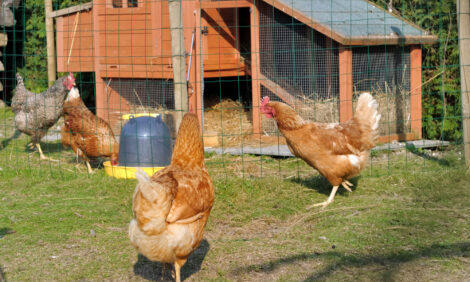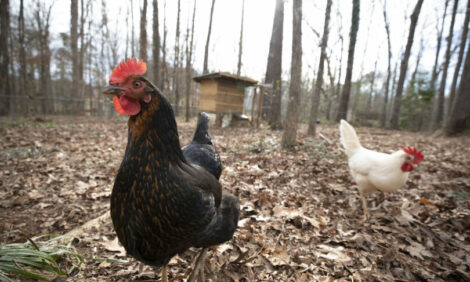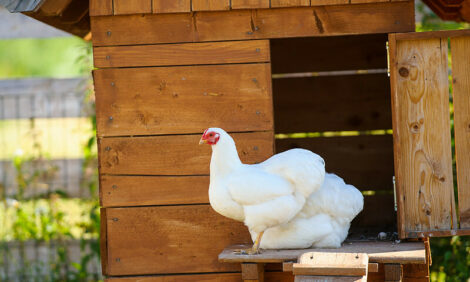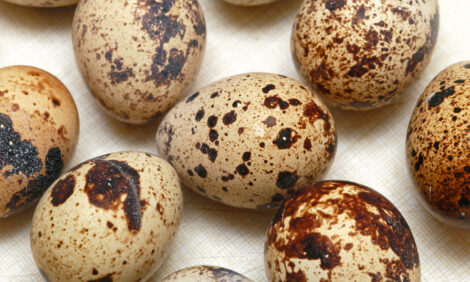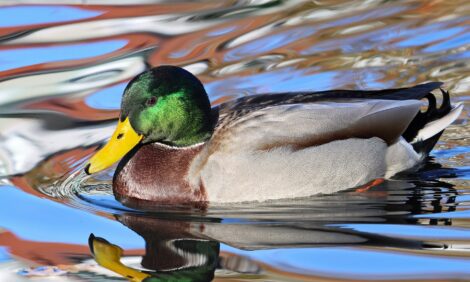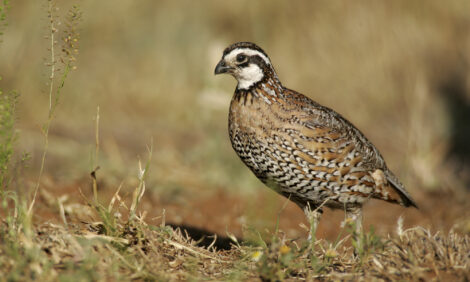



US Poultry Industry Manual - turkey feeding and nutrition
Feed cost and consumption, water feed storage and deliveryPart of Series:
< Previous Article in Series Next Article in Series >
Editor's Note: The following content is an excerpt from Poultry Industry Manual: The Foreign Animal Disease Preparedness and Response Plan (FAD PReP)/National Animal Health Emergency Management System (NAHEMS) Guidelines which is designed to provide a framework for dealing with an animal health emergency in the United States. Additional content from the manual will be provided as an article series.
With average growth rates of toms over 2 lbs (1 kg) and hens around 1.25 lbs (0.6 kg) per week, several different rations are required during the production cycle to provide for the needs of the turkeys and to minimize costs. Programs with 5-7 or more different feeds are fed for 2-4 weeks each. The duration that each feed is given depends on the type of turkey (hen or tom) and growth and development of the turkeys. If their weights are less than the goal, they can be kept on an earlier feed longer to encourage possible compensatory growth.
Feeds must be readily available, palatable, and of good quality. Adequate feeder space for the age of the turkey and a constant supply of feed are essential. Turkeys that do not have feed develop loose, watery, discolored droppings that can rapidly cause litter to deteriorate and "slick over". Feed lines may be broken down by the turkeys and, when feed does arrive, turkeys become frantic trying to get to the feed and often become injured in the resulting mêlée. Also, feed restriction can predispose to feather picking and persecution (“cannibalism”). Height and depth of feed in the feeders need to be constantly adjusted to prevent feed wastage. Eating spilled feed from the litter predisposes to crop mycosis (candidiasis). It is important to examine new feed on arrival to see if it looks the way it should with respect to color, odor, and form, e.g., crumbles for young birds and pellets for older birds. When a flock started on a new load of feed relative to when an excess mortality event occurs, is important to know during a disease investigation.
Although taste is not considered well developed in turkeys, they still respond to feeds and sometimes may refuse to eat them. Smell and texture are likely involved in feed acceptance. Starter feeds composed of good firm crumbles of the correct size (<3mm) are important for young poults. Poults are attracted to bright light and have a preference for green color (Ferket and Gernat, 2006). Spraying green food coloring, putting inducements such as fine grit, rolled oats, or finely minced “greens”, or shining bright lights on the feed may help stimulate newly hatched poults to begin eating. Also, brightly colored marbles placed on feed and in water are occasionally used. Turkeys may appear to be eating, but are actually just picking at the feed and not eating it. A better way to determine if the turkeys are actually eating is to catch a number of turkeys and palpate the crop at the base of the neck on the bird’s right side to determine if it contains food.
As turkeys grow, they are switched to progressively larger pellets. Excessive fine particles ("fines") in the feed reduce consumption and may also contribute to deficiencies, as fines contain a greater proportion of minerals compared to crumbles or pellets. Although it is labor intensive, periodically dumping fines out of feed lines, putting them back into the hopper, and refilling the feeders will stimulate eating. It is a poor practice to turn off feed lines and leave fines in the feeders for turkeys to clean up. Similarly, manually cycling feed lines off and on stimulates feeding. Lighting programs that have periods of light and dark during the night increase feed consumption, but require careful management.
Feeding grit is not as common as it used to be because commercial pelleted rations are easily broken down. However, the practice still remains useful, especially if birds engage in litter or feather eating. Grit enhances growth and development of the ventriculus (“gizzard”). Crushed granite works well, but limestone or crushed seashells also may be used, although the mineral in them is not required if the birds are being fed a commercial ration. Size of grit needs to be appropriate for the size of the bird. Grit is first given at 1-2 weeks of age (2-5 lbs; 1-2 kg per 1000 turkeys) and every 4-6 weeks thereafter at double the initial rate.
Feed Cost and Consumption
Feed accounts for approximately two-thirds of the total cost of production. Small differences in utilization (feed conversion ratio) result in significant economic differences because of the volume of feed required for millions of turkeys in an integrated company. Cost of turkey feed depends on the cost of the main ingredients - corn, soybean meal, and fat. Corn makes up 47-69%; soybean meal 35-18%, and fat 3-6% of starter and finisher diets respectively. Collectively, corn and soybean meal account for 82-87% of ingredients in feeds fed to commercial turkeys. Soybeans contain a trypsin inhibitor that is detrimental to the growth of young turkeys, but is destroyed by heating. The amount of urease, which also is destroyed by heating, is used to determine how well soybeans have been processed. High potassium levels in soybeans can cause diarrhea when used in all-vegetable diets.
Feed conversion ratio varies with the density of the diet. Turkeys eat to fulfill their energy requirements. Balancing protein, especially essential amino acids, with energy is necessary to have a diet that meets the needs of turkeys. Feed conversion ratios for light hens and toms fed typical commercial diets range from 2.0-2.2 and 2.6-2.8 respectively. Approximate feed consumption for light hens, heavy hens, and toms to 14, 18, and 20 weeks respectively is 42 lbs (19.1 kg) , 63 lbs (28.4 kg), and 111 lbs (50.2 kg). Measures of productivity include average daily gain, cost per unit of production, and breast meat yield. Target weights, feed consumption, and conversion ratios are summarized in Table 6.
Table 6. Weekly Target Weights, Feed Consumption, Feed Conversion Ratios, and Average Daily Gain for Commercial Hen and Tom Turkeys. |
|||||||||||
Hens |
Toms |
||||||||||
Week |
Weight (lb) |
Weight (kg) |
Feed (lb) |
Feed (kg) |
Conv. Ratio |
Weight (lb) |
Weight (kg) |
Feed (lb) |
Feed (kg) |
Conv. Ratio |
|
1 |
0.35 |
0.16 |
0.41 |
0.19 |
1.17 |
0.36 |
0.16 |
0.38 |
0.17 |
1.06 |
|
2 |
0.76 |
0.34 |
0.93 |
0.42 |
1.22 |
0.76 |
0.34 |
0.86 |
0.39 |
1.13 |
|
3 |
1.49 |
0.68 |
1.93 |
0.88 |
1.30 |
1.57 |
0.71 |
1.89 |
0.86 |
1.20 |
|
4 |
2.41 |
1.09 |
3.22 |
1.46 |
1.34 |
2.80 |
1.27 |
3.54 |
1.61 |
1.26 |
|
5 |
3.56 |
1.61 |
5.05 |
2.29 |
1.42 |
4.42 |
2.00 |
5.83 |
2.64 |
1.32 |
|
6 |
4.96 |
2.25 |
7.40 |
3.36 |
1.49 |
6.35 |
2.88 |
8.67 |
3.93 |
1.37 |
|
7 |
6.60 |
2.99 |
10.34 |
4.69 |
1.57 |
8.52 |
3.86 |
12.25 |
5.56 |
1.44 |
|
8 |
8.38 |
3.80 |
13.64 |
6.19 |
1.63 |
10.93 |
4.96 |
16.42 |
7.45 |
1.50 |
|
9 |
10.32 |
4.68 |
17.51 |
7.94 |
1.70 |
13.52 |
6.13 |
21.29 |
9.66 |
1.57 |
|
10 |
12.23 |
5.55 |
21.85 |
9.91 |
1.79 |
16.32 |
7.40 |
26.83 |
12.17 |
1.64 |
|
11 |
14.23 |
6.45 |
26.80 |
12.16 |
1.88 |
19.19 |
8.70 |
32.88 |
14.91 |
1.71 |
|
12 |
16.20 |
7.35 |
31.80 |
14.42 |
1.96 |
22.12 |
10.03 |
39.63 |
17.98 |
1.79 |
|
13 |
18.07 |
8.20 |
36.94 |
16.76 |
2.04 |
25.09 |
11.38 |
47.03 |
21.33 |
1.87 |
|
14 |
19.82 |
8.99 |
42.04 |
19.07 |
2.12 |
28.07 |
12.73 |
54.81 |
24.86 |
1.95 |
|
15 |
21.39 |
9.70 |
47.13 |
21.38 |
2.20 |
31.04 |
14.08 |
63.00 |
28.58 |
2.03 |
|
16 |
22.88 |
10.38 |
52.35 |
23.75 |
2.29 |
33.92 |
15.39 |
71.82 |
32.58 |
2.12 |
|
17 |
24.15 |
10.95 |
57.35 |
26.01 |
2.37 |
36.74 |
16.66 |
81.04 |
36.76 |
2.21 |
|
18 |
25.28 |
11.46 |
62.66 |
28.42 |
2.48 |
39.46 |
17.90 |
90.66 |
41.12 |
2.30 |
|
19 |
26.31 |
11.93 |
67.86 |
30.78 |
2.58 |
42.11 |
19.10 |
100.63 |
45.65 |
2.39 |
|
20 |
27.29 |
12.38 |
73.29 |
33.24 |
2.69 |
44.66 |
20.26 |
110.63 |
50.18 |
2.48 |
|
21 |
- |
- |
- |
- |
47.07 |
21.35 |
121.18 |
54.97 |
2.57 |
||
22 |
- |
- |
- |
- |
49.35 |
22.38 |
132.07 |
59.91 |
2.68 |
||
Average daily gains: light hens (14 weeks) - 0.2 lb, 92 g/day; heavy hens (18 weeks) - 0.2 lb, 92 g/day, toms (20 weeks) - 0.32 lb, 145 g/day |
|||||||||||
Source: Aviagen Turkeys and Hybrid Turkeys performance goals |
|||||||||||
Table 7. Essential Amino Acids
*Most likely to be limiting amino acids |
Age and Sex Nutritional Requirements
Young turkeys respond to protein, especially levels of the essential amino acids methionine and lysine. Ten amino acids are essential and must be provided in the diet to avoid restricting growth (Table 7). Limiting amino acids in diets include lysine, methionine, and threonine. Synthetic methionine and lysine are added to diets to supplement what is in feed ingredients. Other essential nutrients include linoleic acid, water- and fat-soluble vitamins, and minerals. Nutritionassociated problems in turkeys include foot deformities, footpad (plantar) dermatitis, and poor feathering associated with lack of B-vitamins that can be destroyed by high heat during pelleting. Spontaneous fractures of leg bones are associated with early diets where the specific nutrient(s) involved have yet to be identified.
In contrast to young turkeys, older turkeys respond more to higher energy levels, which are often provided by adding higher levels of fat to finishing diets. Antioxidants are added to fat to minimize rancidity. The level of rancidity can be determined by a peroxide test. Protein levels decline and energy levels increase in different feeds during the production cycle. Hens and toms receive the same feeds, but the duration each one is fed to each sex is different. A typical feeding program for commercial turkeys using an 8-diet program is presented in Table 8.
Table 8. An 8-Diet Program for Feeding Commercial Turkeys. |
||||||||
Diet |
1 |
2 |
3 |
4 |
5 |
6 |
7 |
8 |
Protein* % |
27.5 |
26.0 |
23.5 |
21.5 |
19.5 |
18.0 |
17.0 |
16.0 |
ME; kcal/lb |
1293 |
1338 |
1383 |
1452 |
1580 |
1576 |
1597 |
1610 |
ME; kcal/kg |
2850 |
2950 |
3050 |
3200 |
3325 |
3475 |
3520 |
3550 |
Lysine % |
1.62 |
1.49 |
1.39 |
1.25 |
1.07 |
0.98 |
0.89 |
0.80 |
Methionine |
0.65 |
0.59 |
0.53 |
0.47 |
0.41 |
0.41 |
0.38 |
0.38 |
Methionine & cysteine % |
1.05 |
0.96 |
0.90 |
0.81 |
0.71 |
0.68 |
0.66 |
0.63 |
Calcium % |
1.40 |
1.40 |
1.30 |
1.20 |
1.10 |
1.00 |
1.00 |
0.90 |
Phosphorus % |
0.75 |
0.75 |
0.65 |
0.60 |
0.55 |
0.50 |
0.50 |
0.45 |
Hens, weeks fed |
0-4 |
4-6 |
6-8 |
8-10 |
10-12 |
12-14 |
14-16 |
16-14 |
Toms, weeks fed |
0-4 |
4-6 |
6-9 |
9-12 |
12-14 |
14-16 |
16-19 |
19-22 |
* Protein and energy levels are balanced. As energy increases, protein is also increased to provide sufficient essential amino acids because feed consumption will go down. |
||||||||
Source: Hybrid Nutrient Guidelines, 2011 Commercial Program [8 phases]. |
||||||||
After selection at around 16 weeks of age, feeds for breeder turkeys are lower in protein and energy than commercial turkey feeds to help control growth. It is important that feeds contain all essential nutrients to support development. To prevent over-conditioning, hens are put on low density conditioning (holding) rations and their weights are closely monitored. Feeding is adjusted to average flocks weights. A few weeks prior to moving to the laying house, breeder replacement hens may be given a pre-lay ration, but, the value of this practice is controversial. The laying ration, containing 2.6-2.8% calcium and 0.35-0.40% available phosphorus, is provided when hens are moved to the laying house and light stimulated. With onset of egg production, feed intake decreases as egg production increases, which results in hens losing up to 2 pounds (1 kg) body weight. Weight loss is apparently essential for optimal egg production. Later, as feed consumption increases, hens gain weight and may be as much as 2 pounds (1 kg) heavier at the end of lay than they were at the beginning of lay. If hens are to be molted and kept for a second egg-laying cycle (“recycled”), this additional weight needs to be lost before they are brought back into egg production.
Feed and Water Intake
Feed consumption varies with temperature. It increases when temperatures are below the turkey’s comfort zone 50-60°F (10-16°C) and decreases when temperatures are higher. Summer and winter rations often differ from each other to account for these differences in consumption. Composition of rations is adjusted to ensure that levels of essential amino acids are adequate. Best feed conversion occurs at higher temperatures around 75-80°F (24-27°C).
Water is essential for feed consumption and growth. As with feeders, adequate water for the age of the turkeys needs to be available. Turkeys do not eat if they do not have water. The rule of thumb is that turkeys consume approximately twice as much water as they do feed, e.g. one quart (0.95 l) of water per pound (0.45 kg) of feed, but in reality this relationship is highly variable. Toms consume more water than hens. Water must be cool and potable. Water consumption increases considerably with increased ambient temperature, feed ingredients, especially sodium and crude protein, and in the early stages of disease. Measuring water consumption daily using a water meter can be useful in identifying early stages of a problem. Approximate water consumption by age and sex is presented in Table 9.
Table 9. Estimated Daily and Weekly Water Consumption per 1000 Commercial Hen and Tom Turkeys at 68-77°F (20-25°C). |
||||||||||
Daily Water Consumption |
||||||||||
Age |
Gallons |
Liters |
Age |
Gallons |
Liters |
Age |
Gallons |
Liters |
||
1 |
15/15 |
55/55 |
9 |
147/176 |
557/667 |
17 |
179/263 |
680/994 |
||
2 |
26/28 |
99/107 |
10 |
166/202 |
629/764 |
18 |
- /264 |
- /1000 |
||
3 |
35/43 |
132/162 |
11 |
174/221 |
660/836 |
19 |
- /265 |
- /1003 |
||
4 |
48/62 |
182/236 |
12 |
176/235 |
666/889 |
20 |
- /266 |
- /1006 |
||
5 |
66/85 |
250/320 |
13 |
177/245 |
669/926 |
|||||
6 |
81/108 |
307/410 |
14 |
177/252 |
671/954 |
|||||
7 |
100/131 |
377/494 |
15 |
178/257 |
674/971 |
|||||
8 |
120/152 |
454/574 |
16 |
179/261 |
677/989 |
|||||
Weekly Water Consumption |
||||||||||
Age |
Gallons |
Liters |
Age |
Liters |
Liters |
Age |
Gallons |
Liters |
||
1 |
102/102 |
385/385 |
9 |
1030/1234 |
3900/4670 |
17 |
1257/1839 |
680/994 |
||
2 |
182/198 |
690/750 |
10 |
1162/1412 |
4400/5345 |
18 |
- /1849 |
- /7000 |
||
3 |
246/300 |
930/1135 |
11 |
1220/1545 |
4620/5850 |
19 |
- /1854 |
- /7020 |
||
4 |
337/436 |
1274/1650 |
12 |
1231/1643 |
4660/6220 |
20 |
- /1860 |
- /7040 |
||
5 |
462/592 |
1750/2240 |
13 |
1236/1712 |
4680/6480 |
|||||
6 |
568/758 |
2150/2870 |
14 |
1242/1765 |
4700/6680 |
|||||
7 |
697/914 |
2640/3460 |
15 |
1247/1796 |
4720/6800 |
|||||
8 |
840/1062 |
3180/4020 |
16 |
1252/1828 |
4740/6920 |
|||||
Increase the above values by 20% for every 5°F (2.8°C) increase in ambient temperature between 75-90°F (24-32°C). Water consumption decreases over 90°F (32°C) because activity of the turkeys decreases. |
||||||||||
Source: NRC Nutrient Requirements of Poultry, 9th ed. |
||||||||||
Least Cost Feed Formulation
Numerous alternate energy and protein sources from grains other than corn, or manufacturing by-products are available to use (NRC Nutrient Requirements for Poultry, 9th edition) depending largely on cost and availability. Computer programs calculate replacement value of non-traditional feed ingredients to arrive at a feed that contains everything required for growth and development, but also is least expensive to manufacture and use. Alternate grain sources, especially wheat, barley, and rye, and soybean meal, contain anti-nutrients (non-starch polysaccharides) which reduce their usefulness for feeding, increase ingesta viscosity that slows digestion and absorption, and cause wet, sticky droppings which can lead to foot pad lesions. Addition of enzymes (β-glucanase, arabinoxylanase, cellulase, and xylanase) to the feed is often used to overcome these problems. Wheat contains very little biotin, which should be increased when wheat replaces part of the corn in a ration. Older varieties of milo (sorghum) contained high levels of tannins that bound proteins and could not be used for feeding young birds, but newer varieties with low tannin levels have been developed and are grown today. Milo also is low in xanthophylls, which results in pale, white carcasses. When using milo, it may be necessary to add pigments to the diet if a more yellow carcass is desired.
Phosphorus is expensive. As much as 60-70% of the phosphorus in plants is bound by phytic acid and unavailable to turkeys as they lack the necessary enzymes. Phytases are used to release the bound phosphorus. In addition, trace minerals bound by phytic acid also are released and made available. Phytase is measured in units; 500 units of phytase will free one gram of phosphorus.
Feed Mixing and Delivery
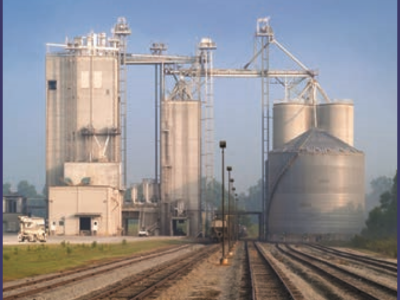
Usually a complex has one large feed mill that is responsible for manufacturing all feeds. Sometimes, the mill also makes feeds for other domestic animals, e.g. pigs or chickens. It is useful to know what feed ingredients, especially ones that may cause a deficiency or toxicity, are in the mill, including ones that may be used for other animals. Feed mills are typically located centrally and adjacent to a railroad. They have their own rail siding to permit buying grain by the train load (80 or more cars is common). Mills have storage capacity for main ingredients, but rarely is the reserve more than enough for a few days' feed production. All steps in the manufacture of feeds are controlled using specialized computer programs. Feeds are accurately produced, unless there is an unrecognized mechanical failure in a bin.
Most commercial feeds are pelleted at high temperatures, 70-90°C (158-194°F), using steam. Advantages include improved growth and feed utilization, increased nutrient availability, decreased waste, improved palatability, decreased selective eating, ease of handling, and killing of vegetative organisms (including Salmonella). However, it is possible for feed to be pelleted at a lower temperature, which needs to be verified if pelleted feed is suspected to be the source of a microorganism. Pellets are formed using a pellet mill. Feed is heated, compressed, and forced under pressure through a die that determines the diameter of the pellet. A roller around the die “nips” off the feed extruded through the die. After pelleting, up to 10% fat can be sprayed onto pellets. When pellets have cooled, thermolabile products such as enzymes or probiotics are applied. Pellet quality depends mainly on the composition of the feed. Some ingredients bind together well to form good quality pellets, whereas others do not. Fines are sifted out and reprocessed.
Feed Delivery to Farm
After feed is made, it is loaded by weight into feed delivery trucks. These trucks have a trailer divided into compartments. Each compartment can be loaded with a different feed or different amount of feed. At the farm, an auger on the truck delivers the feed through the top of a feed bin. Feed deliveries are a biosecurity concern. Trucks are usually decontaminated when entering and leaving the farm. Decontamination on the farm is generally done by the driver using a sprayer provided at the entrance to the farm. More elaborate facilities that provide cleaning and disinfection for all feed trucks are often at or near the feed mill. These facilities have automatic, drive-through spraying with either a drive-through bath or undercarriage sprayers. Drivers should not go into the flocks or, in most instances, get out of the truck. If they do need to leave the truck, they should put on disposable personal protective gear and leave it on the farm when they have finished off-loading the feed. A service technician monitors the amount of feed remaining and orders feed, although in some situations, this may be the responsibility of the grower. Feed remaining after birds have left either a brooding facility or finishing house is picked up and either reprocessed or delivered to another farm. Feed associated with a toxicity problem needs to be destroyed. Usually, this feed is placed into a municipal land-fill.
Feed Storage and Delivery to Turkeys
Each house usually has two feed bins located outside on a concrete pad, next to a drive for the feed delivery truck. Two feed bins per house make it possible to put fresh feed in one bin while older feed is being finished from the other bin. Two bins prevent mixing of fresh and old feed, and allow deliver of a full load of feed. If feed is being weighed, a smaller bin with a scale is used to measure the amount of feed before it is given to the birds. Feed bins on breeder farms may be located just inside the perimeter of the farm boundary line so feed bins can be filled over the fence without the truck having to enter the farm.
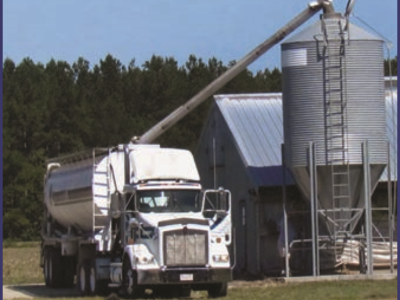
Bins are made of corrugated galvanized metal rings that are joined together. Each ring holds a certain amount of feed. Capacity of the bin can be increased or decreased by changing the number of rings. How much feed remains can be estimated by tapping on the bin and listening for the hollow sound of the empty part of the bin. The roof is slanted to permit visualization of the fill hole in the top used to put feed into the bin. A hinged lid covers the fill hole and a chain extends from the lid to permit it to be raised and lowered without having to climb to the top of the bin. The lid must fit properly, be undamaged, and be closed each time after feed is delivered. The lid should be designed so that it is not blown open by the wind. A ladder extends along the side of the bin to permit access to the lid in case it is necessary to see inside or to clean out the bin. On the bottom of the bin is a cone (center draw hopper) that also contains a known amount of feed. An auger at the bottom of the cone carries feed through a tube into the house. Between the cone and auger is a sliding plate that can be opened or closed to direct feed from one bin or the other. An access port on the auger housing permits examination of feed, feed sampling, removal of foreign material that may jam the auger, and pick up of left over feed. Potential problems with feed storage are overheating during the summer with loss of nutrients, moisture accumulating in the feed and causing bridging so that the feed does not flow easily down the cone to the auger, and foreign material in the feed that gets into the auger and stops it from operating. A steel ball is often put into the cone to help prevent feed from bridging.
Feed flows by gravity from the bin to the auger and is moved into the house where it goes through a drop tube into a hopper on the end of the feed line. A switch that responds to the weight or volume of feed in the hopper automatically turns the auger on and off to keep feed in the hopper at all times. If the switch fails, either the hopper becomes empty causing the feed line to run continuously, or feed will flood the hopper and empty onto the floor. Making sure hoppers are working properly is an important part of daily maintenance. Like the feeder bin cone, a metal ball is often placed into the hopper to prevent bridging and help feed flow freely. At the bottom of the hopper is a boot that connects with the feed line. The feed line consists of a spiral rotating “chain” within a tube. Feed is moved through the tube by the rotating chain. Spaced along the feed line are feeders that are attached to openings on the bottom of the tube. They contain cones that can be raised or lowered to control the level of feed in the pans. After feed floods the pan, it backs up into the cone and feed line to stop the flow of feed to the pan and direct it to other feed pans further along the line. Feeders progressively fill until the end of the feed line is reached where the control feeder is located. It automatically switches the hopper on and off depending on the amount of feed it contains. It is important for turkeys to eat feed from the control pan similarly to the other feed pans in order to keep feeders filled.
Feed Records
A feed ticket accompanies each batch of feed delivered to the house. A copy of the feed ticket is left on the farm. On the ticket is the date and time, information about type of feed, amount of feed delivered, medication(s) added to the feed, concentration of medication(s), and purpose(s) of medication(s).
Reference: "USDA APHIS | FAD Prep Industry Manuals". Aphis.Usda.Gov. 2013. https://www.aphis.usda.gov/aph...
The manual was produced by the Center for Food Security and Public Health, Iowa State University of Science and Technology, College of Veterinary Medicine, in collaboration with the USDA Animal and Plant Health Inspection Service through a cooperative agreement.








